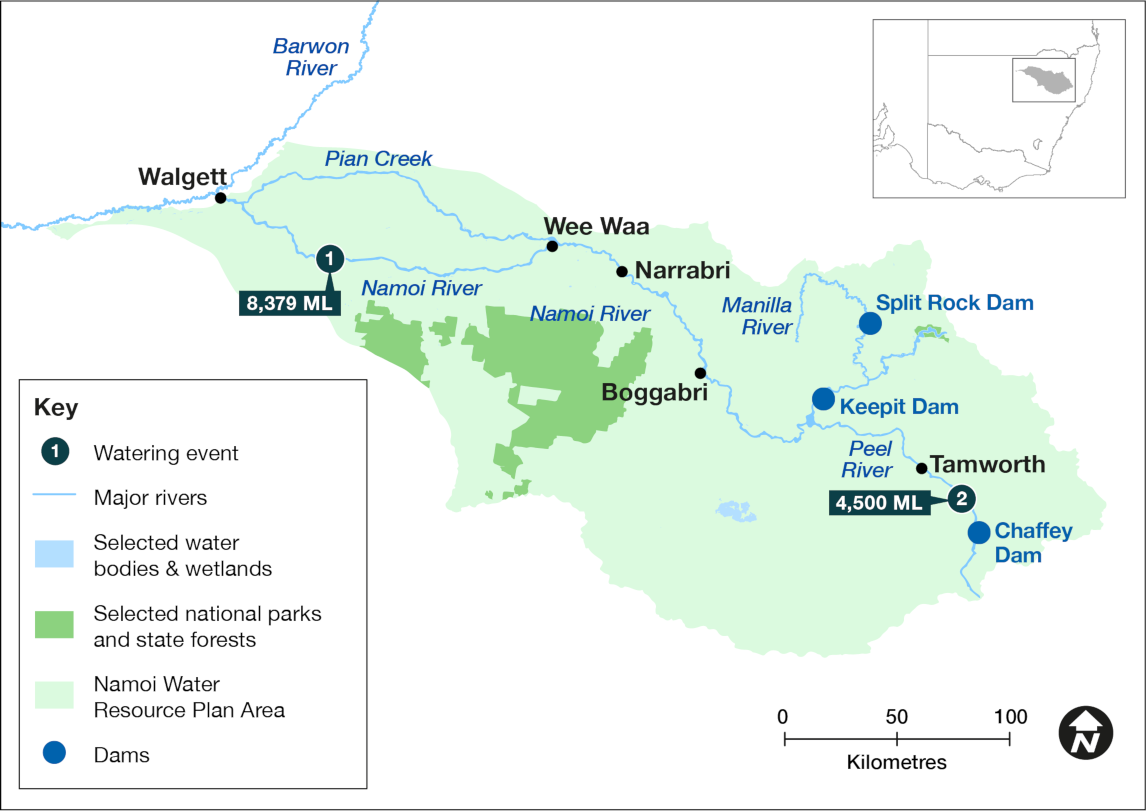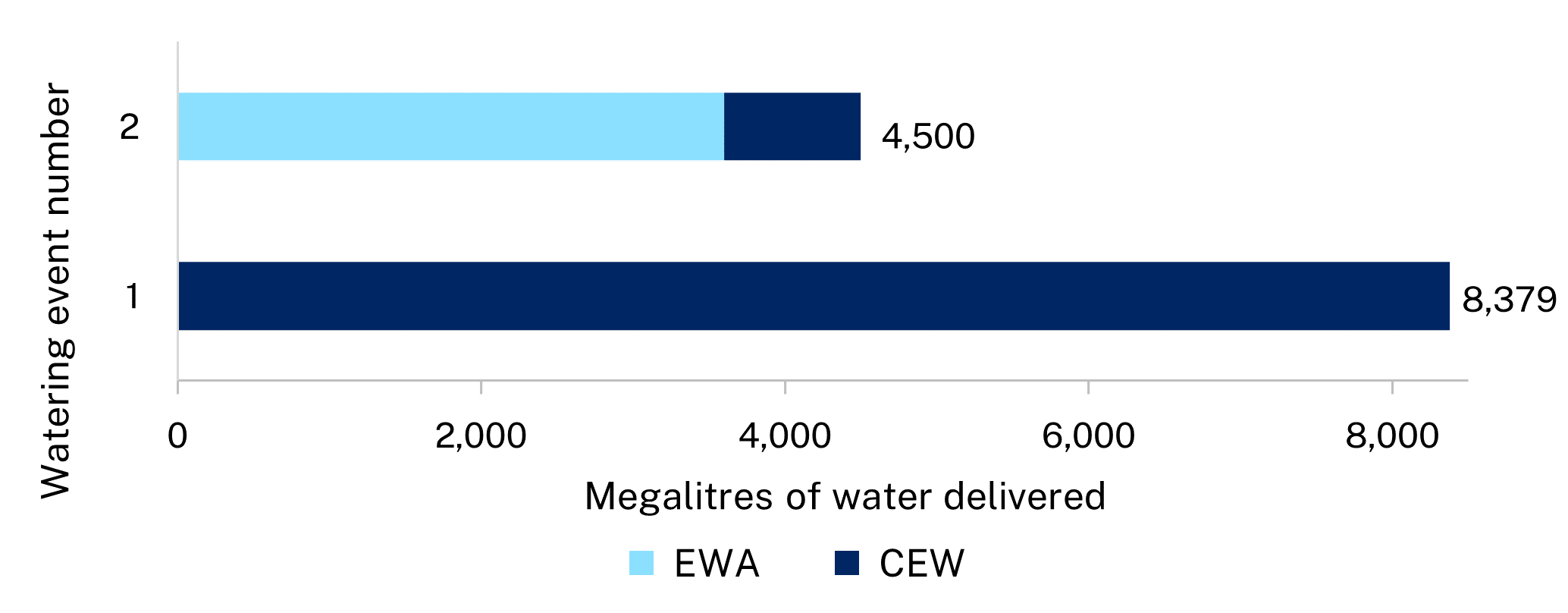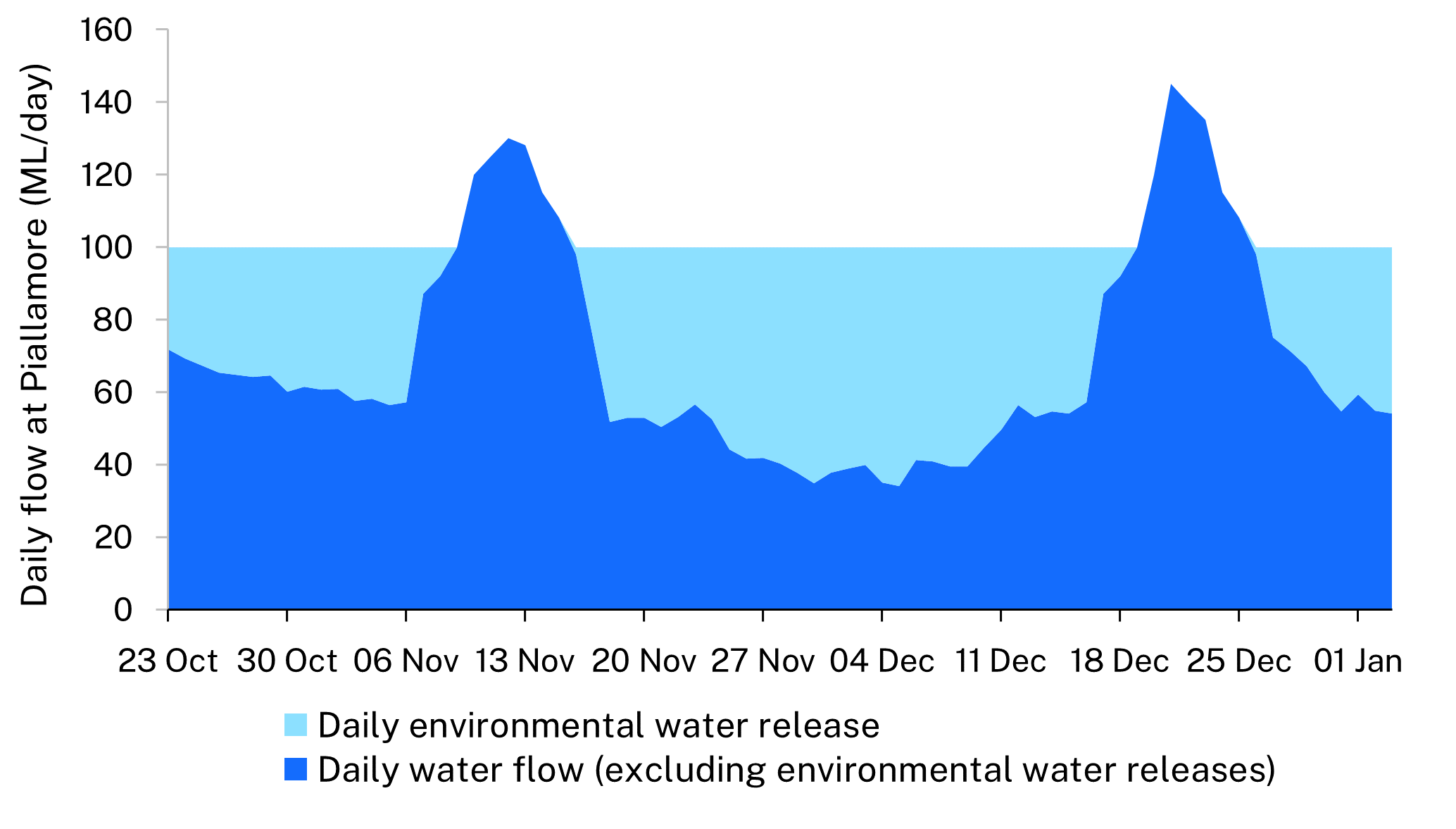In 2023–24 water for the environment boosted native fish and platypus in the Peel River and supported connectivity for native fish in the Lower Namoi River.
Key outcomes
Following two-and-a-half years of flooding, the Namoi catchment experienced a dry spring and summer. To support native fish populations during this period of low natural flows, a total of 12,879 megalitres of environmental water was delivered to the Lower Namoi and Peel Rivers.
Positive results for a platypus survey conducted in the Peel River in April 2024 revealed 3 platypus in good condition, including 2 juvenile-age males. This is a significant improvement from the previous year when 4 platypus were captured in poor health and indicates platypus populations are showing signs of recovery. Ongoing analysis will assess the impact of environmental water on native fish within the Peel River.
In the Lower Namoi River, Commonwealth environmental water was crucial in maintaining a connection between the Namoi and Barwon rivers during spring. This flow provided essential habitat for native fish, allowing them to move between the 2 river systems.

Map of the Namoi catchment showing locations of water for the environment deliveries made in the 2023-24 water year with corresponding volumes.
Catchment conditions
The 2023–24 water year began with below-average rainfall across the catchment. Conditions improved during autumn, providing much needed relief. Overall, the Namoi experienced average conditions. Major headwater storages were full at the start of the year, allowing maximum water allocations for all users, including the environment. General security allocations reached 200% in the Lower Namoi, and 100% in the Manilla, Peel, and Chaffey environmental water allowances.
These changing circumstances heavily influenced the watering approach and outcomes sought. Environmental water managers adapted watering plans in response to catchment conditions and changing environmental needs.
Partnering with Aboriginal peoples
Water for Country is environmental water planned by the Department of Climate Change, Energy, the Environment and Water and Aboriginal people to achieve shared benefits for the environment and cultural places, values and/or interests.
Environmental water managers continue to build relationships with Aboriginal people in the catchment. Work with Dharriwaa Elders Group and Gomeroi representatives through stakeholder advisory groups for environmental water delivery in the Namoi and Peel rivers is ongoing.
Water managers have participated in a project led by the Department of Primary Industries – Fisheries, which aims to include cultural knowledge, experience and perspectives in the fish and flows framework to develop flow-related cultural objectives in support of fish conservation.
Watering aims
With full water accounts, environmental water managers identified water-use objectives in the Annual environmental water priorities in the Namoi catchment 2023–24, which were to:
- increase habitat and mobility opportunities for native fish across the Namoi and Peel rivers and platypus in the Peel River
- provide spawning opportunities for native fish in-channel specialist and flow generalist native fish species
- maintain river connectivity between the Namoi and Barwon rivers
- improve water quality.
At the time of planning, there was high uncertainty about future rainfall. As a contingency, if conditions become dry, water managers would shift the priority in the Peel River to support native fish by delivering very low flows and baseflows to maintain habitat and places for juvenile fish to seek shelter.
Water delivery
This table and chart provide summaries of the 12,879 megalitres of water for the environment delivered in the Namoi catchment during the 2023–24 watering year.
Figures were accurate at the date of publishing but may be adjusted. Watering event numbers in the table and bar chart relate to location numbers marked on the map.

Water delivery to the Namoi catchment in the 2023-24 water year.
Notes: CEW = Commonwealth licensed environmental water; EWA = environmental water allowance accrued under the water sharing plan.
| Water event number | Event name | Outcomes | Start date | Finish date |
|---|---|---|---|---|
| 1 | Lower Namoi late spring fresh | Connectivity | 3 October 2023 | 5 December 2023 |
| 2 | Peel River native fish breeding stable flow | Native fish | 26 October 2023 | 14 January 2024 |
Outcomes
In 2023–24, environmental water managers adopted an adaptive approach to support recovery in the Namoi and Peel rivers. Environmental water was delivered between late-October 2023 and mid-January 2024 to support native fish spawning and recruitment upstream of Tamworth. This joint release between NSW and Commonwealth environmental water managers used 3,600 megalitres of Chaffey Dam Environmental Water Allowance and 900 megalitres Commonwealth licensed water.
A platypus monitoring project, funded by the Commonwealth Environmental Water Holder, is gathering data on platypus populations and their response to changing water conditions. Initial findings indicate improved platypus health and breeding success following environmental water delivery in the Peel River. This project will run until 2025–26.
In the Namoi River, 8,379 megalitres of Commonwealth water for the environment was delivered between 3 October and 5 December 2023. This water was delivered as a small fresh flow followed by a stable baseflow in the lower Namoi River at Goangra. This enhanced habitat for native fish, promoting movement, dispersal, and breeding.
Maintaining stable river conditions with this environmental water supported species like Murray cod, which rely on consistent water levels during nesting. The flow improved water quality and connected the Namoi and Barwon rivers, benefiting other native fish such as golden perch. Without this environmental water, the Lower Namoi River would have experienced significantly reduced flows, impacting both aquatic life and downstream communities.
Case study: filling in the ‘potholes’ for native fish
To support native fish breeding, environmental water managers are using new methods to create more stable river conditions at key times. Species like Murray cod and freshwater catfish rely on steady water levels for successful nesting.
Previously, a fixed volume of water was released daily to maintain target water levels, but this often led to excess water as it didn’t account for other water sources contributing to river flow. A more efficient approach to water use, called ‘pothole filling’, considers all water sources, including natural flows and water being delivered to other users, to achieve the desired water level. This means environmental water is only released when needed to achieve target water levels.
In 2023–24, environmental water managers implemented a ‘pothole filling’ strategy in the Peel River. A target flow of 100 megalitres per day was set at Piallamore to maintain stable water levels for fish breeding from late October to January. Environmental water supported native fish breeding for 81 days using an average daily release rate of 57 megalitres per day, demonstrating significant water savings.

Environmental water was released using a ‘pothole filling’ approach to maintain a minimum flow target of 100 megalitres per day (ML/day) at Piallamore to support native fish breeding. Daily water flow includes water being delivered to other customers.